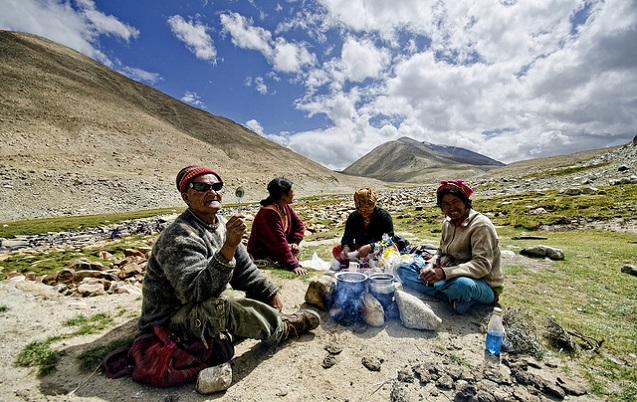
 Prabhu B Doss / Flickr)” width=”637″ height=”402″ />Nomadic picnic, Khardung village, Ladakh, India. (Photo: Prabhu B Doss / Flickr)
Prabhu B Doss / Flickr)” width=”637″ height=”402″ />Nomadic picnic, Khardung village, Ladakh, India. (Photo: Prabhu B Doss / Flickr)
Before the Indian Army built a road to Ladakh in 1962, residents of the Himalayan desert region known as “Little Tibet” had been little exposed to outside ideas. Making a living in one of the highest, driest, and coldest inhabited places on Earth was never easy: Rainfall is less than four inches a year, and in the winter the temperatures go below minus 30 degrees Fahrenheit. But Ladakhis have nevertheless lived an abundant agricultural life that allows them to thrive physically, culturally, and spiritually.
With the building of the road came a flurry of outside influence: material goods, centralized government, and tourism. By the time author and filmmaker Helena Norberg-Hodge first visited the region in 1975, Western pop culture and rampant consumerism were already making it difficult for Ladakhis to sustain the life that had nurtured them for so long.
“There was this romantic picture of Western consumer culture portrayed not only in media and advertising, but also in schoolbooks that made rural small town life seem backward and primitive,” Norberg-Hodge says, describing the shift in attitude among Ladakhis—largely fueled by media exposure—that was making people feel inferior about their modest traditional ways. While the appeal of a modern lifestyle full of instant gratification is understandable, Norberg-Hodge says that there was a clear lack of information, especially among Ladakhi youth, about the realities of life in the West. The underbelly of Western society was still largely invisible in developing countries during the pre-Internet and reality-TV era.
For years, Norberg-Hodge had arranged month-long tours for Europeans to live and work on Ladakhi family farms, to help Westerners connect with what she describes as a less destructive way of life. She also hoped they would relay to the Ladakhis a more complete picture of the impact of conventional development in other parts of the world, such as the long-term effects of pesticides and chemical fertilizers on soil and agriculture. But after watching the transformation of Ladakhi society toward a more Westernized, glamorized lifestyle, Norberg-Hodge had another idea. Her nonprofit, International Society for Ecology and Culture (ISEC), began sponsoring Ladakhi villagers to go on “reality tours” of their own, to experience what everyday life is really like in places like Sweden, Germany, and the United Kingdom.
“I thought it was important for them to know that this fossil-fuel-based urban consumer culture, aside from its huge ecological cost, wasn’t making people happier,” she said.
In addition to experiencing firsthand the side of consumerism that rarely gets shown on TV, reality tours were the perfect catalyst to connect Ladakhis’ traditional cultural and economic values with growing alternative movements in the West. “We really wanted to show them how things like organic food, local community, holistic health care, and natural materials were valued in the marketplace,” Norberg-Hodge says, “because this is what the Ladakhis already had.” If they could see how their traditional ways were becoming not only more and more attractive and popular but lucrative in the West, it would drive home the message that rather than considering themselves backward and old-fashioned, they could play a role at the vanguard of a new global sustainability movement.
With the help of organizations like the International Federation of Organic Agriculture Movements, ISEC has been able to sponsor 50 “reality tourists.” Ladakhis stay with locals for as long as three months, visiting nursing homes, shopping malls, and garbage dumps, as well as local farms and solar energy installations. While they are astounded by the amount of stuff that is thrown away, Norberg-Hodge says the visitors are much more affected by people’s lack of free time, the social segregation of old and young, and the anonymity and lack of interaction with neighbors—even in densely populated apartment buildings. Some of their reactions are documented in Norberg-Hodge’s 2011 documentary, The Economics of Happiness.
“You’d be amazed—this way of life in the West is really not what we think,” Norberg-Hodge reported one woman saying upon returning to her village. “People live right on top of each other in a building and they don’t even know each others’ names. When someone comes to stay they make such a fuss over things like bed linen.”
As a growing number of Westerners are waking up to the social, environmental, and spiritual cost of unbridled consumerism and reacquainting themselves with localized, community-oriented economies, rural communities across the global South can be important models of the interdependent social fabric that has served people so well throughout history. Likewise, while the ethos of materialism continues to encroach on these communities, the exchanges that Helena Norberg-Hodge and ISEC have been facilitating for well over 30 years have shown some villagers that many of their traditional skills and ways of living are worth holding on to.
Join us in defending the truth before it’s too late
The future of independent journalism is uncertain, and the consequences of losing it are too grave to ignore. To ensure Truthout remains safe, strong, and free, we need to raise $29,000 in the next 36 hours. Every dollar raised goes directly toward the costs of producing news you can trust.
Please give what you can — because by supporting us with a tax-deductible donation, you’re not just preserving a source of news, you’re helping to safeguard what’s left of our democracy.